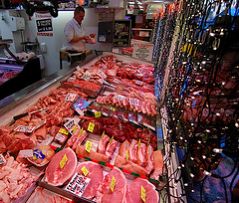 Customers order less meat dishes, especially chicken meat," said Jinlong Han, a restaurant owner in Beijing. "People eat more vegetables than meat after the bird flu issue."
Customers order less meat dishes, especially chicken meat," said Jinlong Han, a restaurant owner in Beijing. "People eat more vegetables than meat after the bird flu issue."Local meat prices keep falling and Han said the price his restaurant paid for chicken legs dropped 22% in one month, from 16 yuan per kilogram (about $1.17 per pound) to 12.4 yuan per kg (about $.91 per pound).
Pork prices have also fallen 33% in the last month, he said, from 31 yuan per kg ($2.27 per pound) to 21 yuan per kg ($1.53 per pound).
The H7N9 avian influenza outbreak has killed at least 11 people and sickened 43, according to an April 12 update from the World Health Organization.
Scientists haven't figured out how the virus spread from poultry to people, and that's generating concern and precaution among Chinese consumers. There's no evidence yet of human-to-human transmission, according to the WHO, and many of the infected Chinese patients had direct contact with the poultry or pork businesses.
Lianliang Wu, 27, helped his father-in-law sell pork in a market in Shanghai and fell ill in late February. He checked into a hospital on March 2. When he died on March 10, the hospital told his family he had died of pneumonia, according to China Youth, a local newspaper. Three weeks later, Wu's family found his name in the name list of bird flu infection cases released by the government.
Beside the news from the government organizations, which mostly released items by government-owned Xinhua News Agency, there is little information released to the public.
Add to it that many Chinese are skeptical of government information on infectious diseases, largely because the Chinese government tried to keep information on the 2003 outbreak of Severe Acute Respiratory Syndrome (SARS) from the public.
The Chinese government tightly controls reporting on avian flu outbreaks. When it eased those restrictions during an outbreak in 2004, partially as a response to criticism of how it handled SARS, Chinese poultry exports slowed to a near halt and people stopped consuming poultry. After that, the government took back control the news reporting of bird flu.
It's unclear what the longer term implications of H7N9 flu virus means for China's soybean imports. According to the China National Grain and Oils Information Center (CNGOIC), soybean meal prices are sliding. The price of meal in the outbreak's epicenter of Jiangsu Province fell 5% from March 27 to April 10, dropping from 4980 yuan ($658) per ton to 3880 yuan ($625) per ton.
Lower poultry and pork consumption in China hasn't hit the U.S. soybean market yet, DTN Analyst Todd Hultman said.
"May soybean meal (futures) dropped significantly from March 27 to April 10, but it was mostly due to the bearish corn stocks report," Hultman said.





